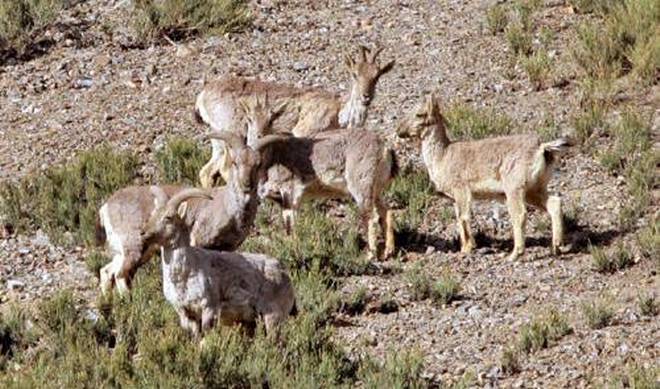Himalayan Blue Sheep
This is a collection of articles archived for the excellence of their content. |
The species, in detail
International Union for Conservation of Nature

From: December 23, 2017: The Hindu
This species is found in Bhutan, China (Gansu, Ningxia-Inner Mongolia border, Qinghai, Sichuan, Tibet, southeastern Xinjiang, and northern Yunnan), northern India, northern Myanmar (Rabinowitz and Tun Khaing 1998), Nepal, and northern Pakistan. Some sources have stated the species exists in Tajikistan (Grubb 2005), but recent evidence for this is lacking.
This taxon remains fairly abundant in most of its principle range among the ranges of the Tibetan Plateau in China (Schaller 1998, Harris 2007). In China, its distribution runs from western Tibet, southwestern Xinjiang (Schaller et al. 1987) where there are small populations in the mountains bordering the western edge of Aru Co, extending eastwards with in scattered populations throughout the autonomous region. It also occurs in southern Xinjiang, along the Kunlun Mountains and in the Arjin Mountains. It is present in most mountain ranges of western and southern Qinghai into eastern Sichuan and northwestern Yunnan, as well as in the Qilian and associated ranges of Gansu. The eastern extent of its current distribution appears to be in the Helan Shan which form the western border of Ningxia Hui Autonomous Region (with Inner Mongolia).
It is found throughout northern Bhutan above 4,000 to 4,500 m asl. Blue Sheep are fairly continuously distributed in the northern Himalayan and Trans-Himalayan regions of India, although the extent of its eastern distribution along the northern border of Arunachal Pradesh is still unknown. They are relatively common in many areas of eastern Ladakh (Jammu and Kashmir), and in parts of Spiti and the upper Parbati valley in northern Himachal Pradesh (Fox et al. 1986, S. Pandey pers. comm.). Blue Sheep are known to occur in the Govind Pashu Vihar Wildlife Sanctuary and Nanda Devi National Park, and near Badrinath (Uttar Pradesh), on the slopes of the Khangchendzonga massif (Sikkim), and in eastern Arunachal Pradesh. Very recently, Blue Sheep presence has been confirmed in the northwestern corner of Arunachal Pradesh near its border with Bhutan and China. In Nepal, it is fairly continuously distributed to the north of the Greater Himalaya from the border with India and Tibet in the extreme northwest, eastwards through Dolpo and Mustang to Gorkha district in north-central Nepal. It then re-occurs in Nepal in at least two isolated areas: in Lamobogar, and on the southwestern slopes of Kanchenjunga near the border with Sikkim (India) (Schaller 1977, Wegge 1991). These two are probably connected with more extensive populations across the border in Tibet.
Its main distribution range in Pakistan includes the upper Gujerab valley, the upper Shimshal valley, and the area eastward from Shimshal pass (District Gilgit), including part of Khunjerab National Park (Schaller 1976; Roberts 1977; Rasool 1986; Wegge 1988, 1989; G. Tallone in litt. 1993). Outside these areas there is a single, recent observation of one animal from Khunjerab pass (R. Hess pers. obs. 1985). Earlier, Roberts (1977) mentioned its occurrence (with proof) around Shigar and the Baltoro glacier (District Baltistan), however, we have no actual information from this area. Roberts’ (1977) source for its occurrence in the Passu valley was a quote from Lydekker (1907) who mentioned “Hunza valley, near Passu”, but possibly meaning the Shimshal valley. The presence of the species in the Passu valley is not confirmed (D. Mallon pers. obs. in litt.).
Grubb (2005) indicates that Blue Sheep can be found in Tajikistan, but documentation for this is not provided, and recent surveys of the Pamir area have failed to mention find evidence of occurrence in Tajikistan (Magomedov et al. 2003, Schaller 2005), or neighboring regions of Taxkorgan County in Xinjiang, China (Schaller 2005) or Afghanistan (Schaller 2003). Maps of the species' distribution can be found in Shackleton (1997) and Schaller (1998).
Infected with unknown virus?
December 2017/ National Green Tribunal issues notice to Uttarakhand and Central govt.
The National Green Tribunal issued notices to the Uttarakhand government and the Centre after a petitioner alleged that an unknown virus was adversely affecting wildlife in the Himalayas.
A Bench headed by NGT acting Chairperson U.D. Salvi, issued notices to the State government, Ministry of Environment Forest and Climate Change and the Ministry of Wildlife and Environment of Uttarakhand, over the allegations.
Petitioner Gaurav Bansal claimed that the Himalayan blue sheep were affected by the ‘unknown virus.’
“The biodiversity of the Gangotri National Park in Uttarkashi is endangered because of an unknown virus or disease. Furthermore, it is also important to mention that the Himalayan blue sheep of the Gangotri National Park are getting blind because of the said virus or disease” read the petition.
Eye infection
Further, the petitioner alleged that the matter had come to light after a group of Border Security Force personnel, who were camping at the national park, came across several Himalayan blue sheep with either bleeding eyes or empty eye sockets.
Highlighting the urgency of the situation, the petition read, “It is important to mention that if the respondents fail to prevent or control the said disease then there is a high probability of its spreading through oral or faecal air-borne mediums.”
The NGT has directed the authorities to file their replies.